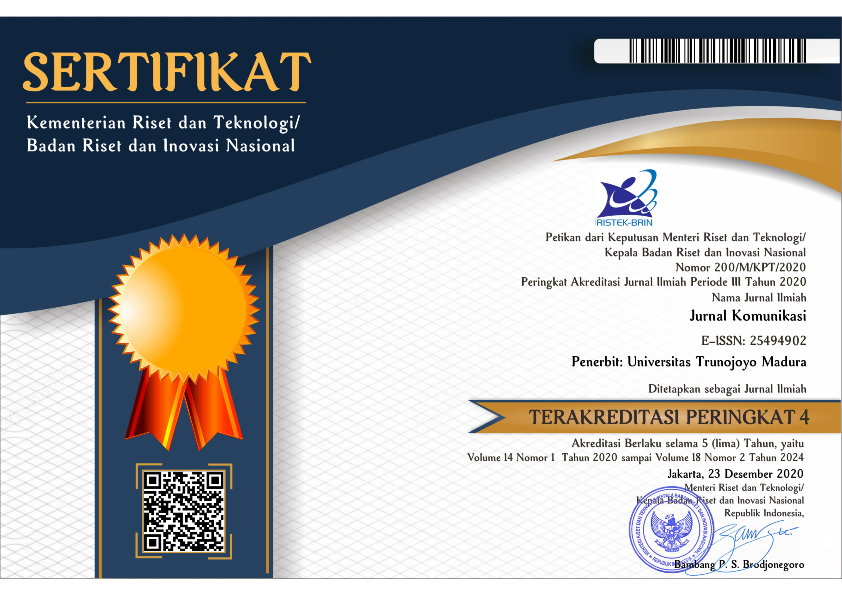DINAMIKA KOMUNIKASI ORGANISASI MASYARAKAT MARJINAL (Studi Pada Komunitas Perempuan Pekerja Seks Yogyakarta)
Abstract
Keywords
Full Text:
PDFReferences
DAFTAR PUSTAKA:
Fakih, Mansour. (2013). Analisis Gender & Transformasi Sosial. Yogyakarta: Pustaka Pelajar
Fakih, Mansour. (2013). Runtuhnya Teori Pembangunan dan Globalisasi. Yogyakarta: Pustaka Pelajar
Farihanto, Muhammad Najih. (2010). “Komunikasi Organisasi Dalam Penanaman Budaya Organisasi Di Seminari Tinggi Santo
Paulus Yogyakarta.” : 179–94.
Ibrahim, Syafei. (1979). “Komunikasi Sebagai Faktor Determinan Dalam Organisasi.”: 291–301.
Ishak, Aswad. 2012. Peran Public Relation dalam Komunikasi Organisasi. Jurnal Komunikasi, Volume 1, Nomor 4, Januari 2012. Hlm. 373-380
Kuswarno, Engkus. (2001). “Efektivitas Komunikasi Organisasi.” Mediator 2(1): 55-61. repository.usu.ac.id/bitstream/123456789/47147/4/ChapterII.pd.
Maryani, Anne. (1997). “Komunikasi Persuasif, Kohesi Kelompok, Dan Apresiasi Seni Gamelan Sunda: Kasus Di Kalangan
Mahasiswa Anne.”
Johnson, David dan Frank P. Johnson. (2012). Dinamika Kelompok: Teori dan Keterampilan. Jakarta: Indeks
Jorgensen W. Marianne dan Louise J. Phillips. (2010). Analisis Wacana: Teori dan Metode. Yogyakarta: Pustaka Pelajar
Nasution, Zulkarimen. (2009). Komunikasi Pembangunan: Pengenalan Teori dan Penerapannya. Jakarta: Rajawali Pres
Perhimpunan Perempuan Pekerja Seks Yogyakarta. (2014). Dari Sarkem, Di Balik Stasiun Hingga Di Antara Debu Terminal:
Mozaik Kisah Perempuan Perkasa. Yogyakarta: PKBI
Rahmanto, Aris Febri. (2004). Peranan Komunikasi Dalam Organisasi. Jurnal Komunikologi Volume 1 Nomor 2. Hlm.
–75.
Rakhmat, Jalaluddin. (2015). Psikologi Komunikasi. Bandung: Remaja Rosdakarya
Sudarto. (2013). Silaturahmi Kelamin: Menyingkap Tabu-Tabu Dunia Perkelaminan. Yogyakarta: Pintar
Sugiono, Muhadi. (2006). Kritik Antonio Gramsci Terhadap Pembangunan Dunia Ketiga. Yogyakarta: Pustaka Pelajar
DOI: https://doi.org/10.21107/ilkom.v12i1.3711
Refbacks
- There are currently no refbacks.
Copyright (c) 2018 ERWIN RASYID

This work is licensed under a Creative Commons Attribution-ShareAlike 4.0 International License.
Jurnal Komunikasi by Universitas Trunojoyo Madura is licensed under a Creative Commons Attribution-ShareAlike 4.0 International License.














